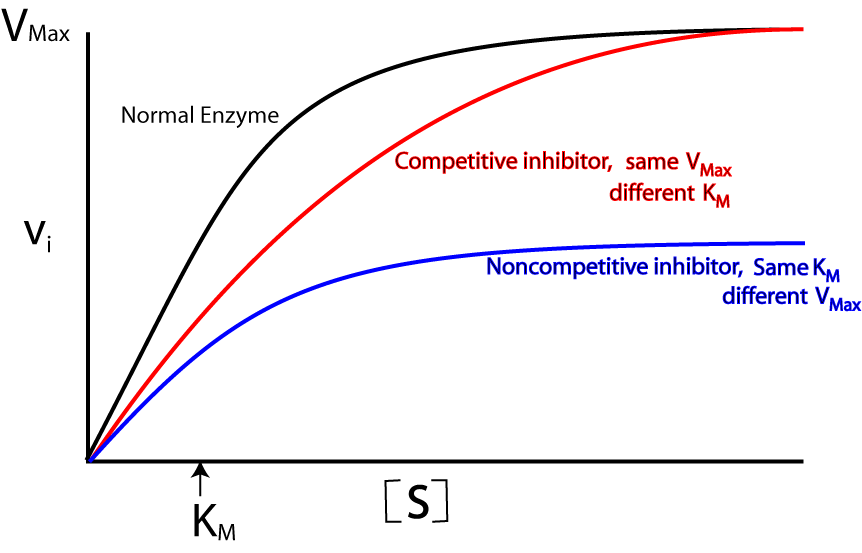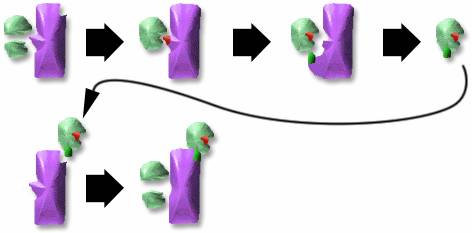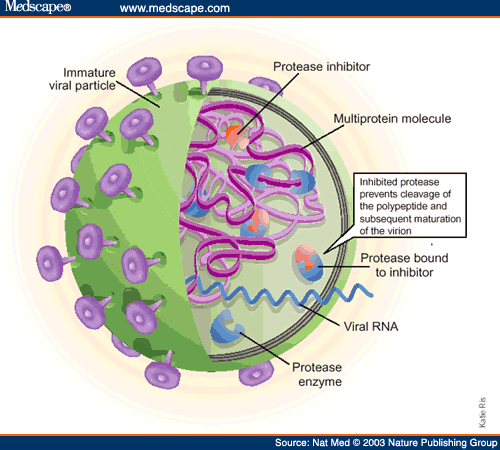Enzyme Inhibitors
Enzyme Inhibitors reduce the rate of an enzyme catalysed reaction by interfering with the enzyme in some way. This effect may be permanent or temporary.
Competitive Enzyme Inhibitors work by preventing the formation of Enzyme-Substrate Complexes because they have a similar shape to the substrate molecule.
This means that they fit into the Active Site, but remain unreacted since they have a different structure to the substrate. Therefore less substrate molecules can bind to the enzymes so the reaction rate is decreased.
Competitive Inhibition is usually temporary, and the Inhibitor eventually leaves the enzyme. This means that the level of inhibition depends on the relative concentrations of substrate and Inhibitor, since they are competing for places in enzyme Active Sites.

- Non-competitive Enzyme Inhibitors work not by preventing the formation of Enzyme-Substrate Complexes, but by preventing the formation of Enzyme-Product Complexes. So they prevent the substrate from reacting to form product.
Usually, Non-competitive Inhibitors bind to a site other than the Active Site, called an Allosteric Site. Doing so distorts the 3D Tertiary structure of the enzyme, such that it can no longer catalyse a reaction.
Since they do not compete with substrate molecules, Non-competitive Inhibitors are not affected by substrate concentration.

Many Non-competitive Inhibitors are irreversible and permanent, and effectively denature the enzymes which they inhibit. However, there are a lot of non-permanent and reversible Non-competitive Inhibitors which are vital in controlling Metabolic functions in organisms.
Enzyme Inhibitors by organisms are used in controlling metabolic reactions. This allows product to be produced in very specific amounts.
Enzyme Inhibitors in Metabolic Control
Enzymes vastly increase the rate of a metabolic reaction, often by a factor of 10 million. This fact is essential to all life on earth, but it means that Enzyme activity must be very tightly controlled, since uncontrolled reactions can be fatal.
For example, in the disease ‘multiple sclerosis’, the immune system starts destroying nerves by allowing destructive Enzymes to attack nerve cells, often resulting in paralysis.
Often a Metabolic Process is composed of many different reactions, each of which is catalysed by a different Enzyme. These are reactions are called Metabolic Pathways. For example, photosynthesis has a Metabolic Pathway.

- In many cases, the final product of a Metabolic Pathway acts as a Non-competitive Inhibitor to one of the enzymes earlier along the chain. This means that the Metabolic Process controls itself, since the more product gets produced, the more it inhibits the pathway, and so the slower the process proceeds.
Enzyme Inhibitors as Metabolic Poisons
Many poisons work by inhibiting the action of enzymes involved in Metabolic processes, which disturbs an organism.
For example, Potassium Cyanide is an irreversible Inhibitor of the enzyme Cytochrome C Oxidase, which takes part in respiration reactions in cells. If this enzyme is inhibited, ATP cannot be made since Oxygen use is decreased. This means that cells can only respire Anaerobically, leading to a build up of Lactic Acid in the blood. This is potentially fatal.
The poison Malonate binds to the Active Site of the enzyme Succinate Dehydrogenase competing with Succinate, which is important in respiration.
Enzyme Inhibitors as Medicines
Some Enzyme Inhibitors can be used as Medicines in the treatment of conditions.
For example, infection by viruses can be treated by Inhibitors to the viral enzyme Protease, often competitive Inhibitors. This means that viruses cannot build new protein coats and therefore cannot replicate.

- Penicillin works by Inhibiting a bacterial enzyme that is responsible for forming cross-links in bacteria cell walls. This therefore halts reproduction.